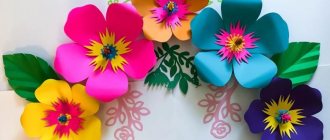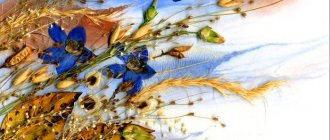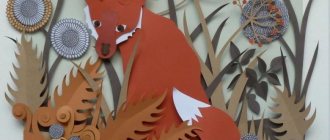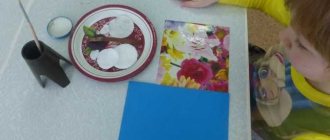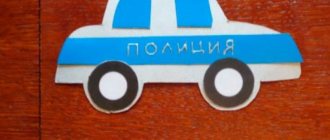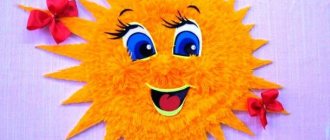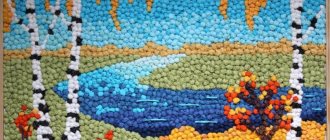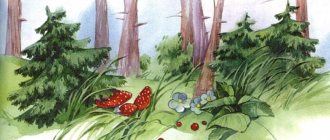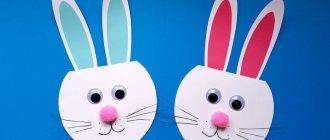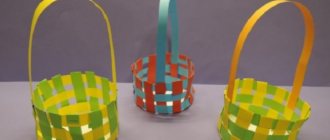Children's creativity not only contributes to the development of artistic taste and fine motor skills, but also broadens the child's horizons. Creating landscapes using the appliqué technique will help kids learn the concepts of perspective and horizon. The theme of the autumn forest will help kids learn the signs of this time of year.
Tell your children about autumn and let them make crafts according to their taste, without being limited by rules. Even if the first works do not really meet the requirements, they are still beautiful, because the child filled them with his imagination and sincere love for this world.
Applique autumn forest made of colored paper
Crafts on this topic can be made even with children in the younger group of kindergarten. At this age, children already know the features of the seasons and can create the correct color palette for the appliqué.
To practice fine motor skills, it is best to use torn paper technology. Choose soft colored paper, as tearing thick paper can cause your child to cut himself.
First make the background. Cover the bottom half of the sheet with green paper with a torn edge. The green should not be too bright as it is an autumn grass. You can add accents by drawing individual blades of grass. Stick blue clouds on the sky.
Cut out tree trunks from brown paper and arrange these objects on the background sheet. There is no need to require the same arrangement; let the children show their imagination and make original compositions. Glue the trunks.
Take colored paper in autumn shades (red, orange, yellow, light brown) and tear it into pieces about 1x1cm. Then randomly glue them onto the top of the trunks, as well as onto the ground, like fallen leaves.
Children from the preparatory group can make a more complex application “Hedgehog in the autumn forest” in this way. From gray paper, cut out the shape of a hedgehog (an oval with a nose), and use a black felt-tip pen to draw needles, eyes and a nose for the hedgehog. Cut out apples from red paper and stick them on the back of the hedgehog.
Collective application
This type of work occupies a special place in the preparatory group. During the process, children are given freedom in choosing material and interpreting the task. When doing work, children should show more imagination, be more proactive, and learn to solve assigned tasks as a team. The topic set should give scope for creativity, provide an opportunity to apply existing knowledge from the field of social life, natural phenomena, and works of art. For a collective application, themes such as “On a construction site”, “Inhabitants of the deep sea”, “Summer colors”, “Autumn carpet” can be used.
Video notes of appliqué classes with kids will be an excellent help in a deeper study of this topic:
Forest applique of autumn leaves
Working with natural material is quite complicated; it requires preparation and careful handling of fragile leaves. Typically, an application of leaves on the theme “Autumn Forest” is done in 2nd grade.
The material for this craft must be prepared in advance by drying the leaves. To prevent the composition from looking sad, find leaves that retain a bright color after drying. For example, red wild grape leaves or yellow linden leaves.
The collected raw materials need to be laid out with newspapers and weighed down with something heavy, leaving in this form for three to four days. If the material is needed urgently, it can be quickly dried with an iron. To do this, the sheet is placed between two sheets of paper and ironed for ten minutes.
Cut out or draw a tree trunk from paper. Glue the leaves using PVA glue.
Older children can cut the leaves into small pieces and make a craft using the collage technique.
Application for the younger group on the theme of autumn
Applications made from natural materials in kindergarten are not very complicated. For them you can use not only leaves, but seeds, acorns, twigs. Colored paper and cardboard are also used.
Autumn flower applique
Beautiful colorful leaves that fall to the ground from trees can be transformed into an autumn flower. You can create such a flower using glue and a sheet of cardboard.
If one flower is not enough, then you can make a vase with flowers from autumn leaves.
Beautiful umbrellas will be made from pieces of colored paper. This type of applique is called cut-off.
Volumetric applique of autumn forest
This method requires some skills and is accessible to children of primary school age.
Take white birch paper and draw black marks. For a voluminous central trunk, cut a strip of 9x17 centimeters and screw it into a tube onto a marker, gluing the edge so that the tube retains its shape.
Attach strips of 10x4 centimeters in the same way, using a pencil, to get thinner tubes. Roll the paper along the long edge, so you will get a thick tube 17 centimeters long and several thin ones 10 centimeters long.
Glue them in the form of a central trunk with branches on the sides. Using a template or a hole punch, cut out leaves from paper in autumn shades and attach them evenly along the branches.
For originality, you can add autumn fruits, such as apples.
How does the application help in studying the world around us?
As a sample for appliqué, children are most often provided with a real object, for example a leaf, a spikelet, or various containers. It is very important to teach them to convey the real ratio of the size of things to each other, their real shape and color. Mushrooms are perfect for these purposes. While doing the work, children remember the names, learn to distinguish between species, and determine whether they are poisonous or non-poisonous.
The skills of accurately conveying a design are developed using images of various vehicles. By assembling an image from individual parts, children in the process of work gain knowledge about the structural features and purpose of a particular type of transport.
Application themes related to fairy-tale images will help children develop their creative abilities and use their imagination. Tasks to depict fictional animals and bright buildings activate the child’s thinking and independent search. In such work, preschoolers receive freedom of action and the opportunity to creatively apply the knowledge and skills acquired earlier, change colors and shapes at their discretion, add or remove structural elements.
One of the most difficult tasks is for preschool children to master the skills of creating representatives of the animal world - birds, fish, domestic animals. This application requires the presence of small details, compliance with the exact parameters of the silhouette and color. Having mastered this step, children move on to depicting moving figures. Here certain difficulties arise with children conveying the dynamics of the animal, acquiring an understanding of how its body changes while jumping, running, etc.
Having mastered the skills of appliquéing individual objects, preschoolers move on to combining them into complete images and related plot pictures. Their works reflect such themes as “Fruit Bowl”, “Spring Bouquet”, “Migratory Birds”, “Hares in a Forest Clearing”, “My Family on a Walk”.
Autumn forest made from rolled strips of paper
Prepare an autumn background for the application and determine the location of the trees on the sheet.
Three-dimensional trees can be made in three ways.
The first method: cut strips of 1x5 centimeters from colored paper in autumn shades. We glue each strip into a ring, the colored side out. Glue the resulting rings sideways onto the trunk in a chaotic manner. Try to glue so that the joint line is hidden at the bottom.
Second method: Cut a strip of paper 1.5x20 centimeters and wind it in a spiral around a pencil. Make 10 spirals in this way and glue them to the paper, placing them like rays from one point in the center of the trunk.
Glue smaller leaves on top of each spiral. Leaves can be cut out using a template or punched out with a hole punch.
Third method: willow or birch. Cut out many strips of 0.5 x 20 centimeters and screw them very tightly onto a toothpick so that you almost get a tube. Draw a willow or birch trunk with drooping branches. Glue the resulting spirals to the ends of the branches.
Autumn forest applique made from cotton pads
This technology is perfect for children aged three years and older. Since the disks are quite large, this method is more suitable for single trees. Prepare red, orange and yellow paints. For this craft, it is better to use gouache, as watercolor will give lighter colors.
Paint 10-15 discs and dry. You can paint with a brush or dilute the paints and drip from a pipette. If you use several colors on one disk, the colors will mix with each other and give new shades, which will allow you to more fully convey the color scheme of autumn.
Glue the barrel onto a sheet of paper and painted cotton pads on top.
Applique autumn forest from other materials
You can use many materials to create a beautiful and unusual applique. It all depends on the desire and capabilities of the master.
Application from plasticine
Since plasticine is quite heavy, applique requires a solid base, such as cardboard or fiberboard. You can use a disposable plate. You need the softest plasticine so that it spreads easily.
For the background, roll out two green sausages and one light brown one, then assemble them into one sausage without kneading. Tear off pieces and spread where the soil should be.
There is no need to mix the colors into one; let the effect of chaotic spots remain, as if part of the grass has already dried out. Smear blue across the sky, occasionally adding white.
Sculpt or paint with gouache. Roll many 5mm balls in the color of autumn foliage. Each ball must be attached to the base and squeezed to form a flat cake.
Use these flatbreads to fill the space of the tree crown. You can make mushrooms from white and brown plasticine and place them between the trees.
Cereal application
For the “Autumn Forest” applique you need buckwheat, millet, wheat and other cereals. The paper should be thick enough, since you will have to use a lot of PVA glue, and the thin paper will get wet.
It is better to paint the background and contours of the trunks. Apply glue to the tree crowns and sprinkle with cereal. You can use a separate type of grain for each tree or mix all grains together. The work should lie until the glue dries completely.
A craft with seeds is made in a similar way. Pumpkin seeds are painted with gouache in the colors of the autumn palette, and then glued to the base.
To develop children's imagination, invite your child to choose his own materials for crafts. For example, paper can be replaced with fabric or felt. Let your child get acquainted with different textures and materials.
It is in early childhood that the child’s imagination develops most actively. Don't miss this moment and grow a creative person.
Text of the book “Modeling and applique with children 6-7 years old. Class notes"
Daria Nikolaevna Koldina Modeling and application with children 6–7 years old: Lesson notes
From the author
For the harmonious development of a child’s personality, it is very important to introduce him to the world of beauty through visual activities (drawing, modeling, appliqué). Drawing, modeling and applique develop fine motor skills, help shape thinking and develop artistic perception and creativity in children. These activities also occupy one of the most important places in preparing a child for school.
The year before school is a very important period in a child’s life, and all further school studies largely depend on it. If the child is ready for it, he will go to school with joy and learning will be easy and pleasant for him.
Children aged 6–7 years expand their knowledge of fine arts, they get acquainted with works of painting, small sculptures, and the works of book illustrators.
In sculpting
the ability to convey forms, proportions, poses, characteristic features and movements of depicted objects is consolidated. Six-year-old children are able to sculpt sculptural compositions of two or three figures of comparable size, united by a common plot, and make folk toys.
During applique
The ability to cut out parts of objects and entire silhouettes from paper, the ability to cut out symmetrical parts from paper folded in half, and several objects or parts of them from paper folded like an accordion are consolidated. The ability to create a decorative composition from geometric and plant shapes is consolidated. The ability to correctly position an applique on a sheet develops. Acquaintance with the possibilities of the art of ikebana and the technique of openwork cutting continues. In collective work, children learn to plan and coordinate their actions.
In this manual we offer notes on exciting classes in modeling and appliqué.
The classes are organized according to the thematic principle: one topic unites all classes (on the surrounding world, on speech development, on modeling, on appliqué, on drawing) during the week.
A sculpting or applique class is held once a week and lasts 25–30 minutes. Classes in modeling and appliqué do not necessarily have to strictly alternate; for example, you can conduct one lesson in modeling, then three in appliqué, and vice versa. The manual contains 36 notes of complex classes (18 on modeling and 18 on appliqué), designed for the academic year (from September to May).
Read the lesson notes carefully in advance and, if something doesn’t suit you, make changes; prepare the necessary material and equipment.
Preliminary work is also important (reading a work of art, becoming familiar with surrounding phenomena, looking at drawings and paintings).
It is advisable to conduct a lesson on modeling or applique before the children draw on this topic.
Modeling classes are structured according to the following approximate plan:
1. Creating interest and emotional mood (surprise moments, poems, riddles, songs, nursery rhymes are used; acquaintance with works of fine art; reminders of what was seen earlier; the appearance of a fairy-tale character in need of help; dramatization games; exercises for the development of memory, attention and thinking; outdoor games).
2. The process of completing the work begins with an analysis of the depicted object, the teacher’s advice and children’s suggestions for creating the work; in some cases, display of image techniques is used. Next, the children begin creating their own works. The teacher can draw their attention to a successfully started craft; direct the actions of children in need of support and assistance. When modifying a product with additional elements, children should pay attention to expressive means (correctly selected colors and interesting details).
3. Review of finished works (in this case, the teacher gives only a positive assessment). The child should be happy with the result obtained, learn to evaluate his craft and the work of other children, notice new and interesting solutions, and see similarities with nature.
In modeling classes with children 6–7 years old, the following modeling methods are used.
1. Constructive - sculpting an object from separate parts.
2. Plastic - parts of an object are pulled out from a whole piece.
3. Combined - a combination of different modeling methods in one product.
4. Relief sculpture - a three-dimensional image protruding above the plane that forms its background.
Types of reliefs:
– bas-relief – low relief (the image protrudes above the plane by less than half (coins, medals));
– high relief – high relief (individual parts can completely protrude above the plane (walls of architectural structures));
– counter-relief – depressed relief (the image is recessed into the plane).
Let's list the sculpting techniques:
which can be used by children 6–7 years old:
• rolling balls (any work begins with the use of this technique): a piece of plasticine is placed between the palms and the palms are made in a circular motion;
• rolling out columns using palm movements back and forth on a board;
• flattening or flattening of balls and columns between fingers or palms;
• pinching or pulling: pinch the plasticine between two or three fingers and pull lightly;
• pulling out individual parts from a whole piece: with your thumb and forefinger, gradually press the plasticine from all sides (you can roll out the column only on one side and get a narrowed cone-shaped shape);
• pressing indentations on the surface of the mold with your thumb;
• connecting parts into a single whole and smoothing the joints;
• flattening the bottom of the mold by tapping it on a board to make the craft stable;
• drawing on plasticine using a counter-relief method using a stack, a pointed stick;
• decorating crafts with various additional and natural materials: short sticks, straws, cut maple or ash wings, buttons, pennies, woolen threads, etc.;
• decoration of an object with small details sculpted from plasticine;
• mixing several colors in one piece of plasticine: take 2-3 pieces of plasticine, twist them and knead them - you will get multi-colored plasticine.
Secrets of working with clay
Many adults do not really like working with clay, not understanding all its intricacies. Therefore, clay modeling classes are often replaced with plasticine modeling. To understand the secrets of clay, read the following tips carefully.
• A day before class, remove the clay from the plastic wrap, wrap it in a wet rag and put it in a bag.
• Before class, all the clay must be thoroughly kneaded, then divided into pieces and distributed to the children.
• Children bring the clay to full readiness - continue to knead it. If the clay is too wet, it will stick to your hands. It should be kneaded longer until it becomes plastic and will easily come off your hands and roll into a sausage. If the clay cracks - it is too dry - moisten it with a small amount of water and continue kneading until completely ready. If this is not done, the craft will crack when drying. Only clay that is plastic, easily sticks to your hands, and does not crack is suitable for modeling.
• Prepare a bowl of water where you will wet your hands.
• Now you can sculpt your intended object on a wooden plank! This is important because the plastic clay will stick too much and crack.
• The joints of the clay must be moistened with water, otherwise the craft may fall apart when drying.
• Using wet fingers, smooth out any uneven surfaces on the craft.
• If you did not have time to finish sculpting an object in one lesson, carefully wrap the unfinished work in a damp cloth and put it in a plastic bag.
• Dry the clay product naturally for 3-4 days.
• Then you can fire the craft in a muffle furnace at a temperature of 800 °C. After firing, the clay will turn red-brown.
• The finished product can be painted, for example, with tempera, gouache or watercolor and varnished.
• Wrap the remaining mass after modeling again in a cloth and put it in a plastic bag. If a damp rag begins to mold during storage, replace it with a new one and wash out the clay.
• After work, wash your hands under the tap and tidy up your work area using sponges.
If there is no clay, you can use homemade soft and plastic dough. You can prepare it in two ways.
1st method.
Mix 0.5 cups of salt, 0.5 cups of flour, 0.5 cups of water and 1 teaspoon of sunflower oil. The dough is ready to work.
2nd method.
Mix 1 cup flour, 1 cup water, 0.5 cup salt, 1 tablespoon vegetable oil and 2 tablespoons citric acid. Cook, stirring for 2-3 minutes.
Finished products should be dried on both sides and then painted with gouache.
Let's list the application methods:
which can be used by children 6–7 years old.
• Applique from cut out parts of an object (the object is made up of parts and glued to paper).
• Applique from cut out silhouettes of objects (a composition is made of one or several objects and pasted onto a sheet of paper).
• Decorative applique of cut out stripes and geometric shapes.
• Tear-off mosaic (small circles, triangles, squares or torn pieces of colored paper are glued inside the outline).
• Cutting along the contour (colored paper is torn along the intended contour to convey the texture of the object).
• Rolling napkins (the paper is torn into small pieces, each piece is wrinkled and rolled into a ball).
• Overlay applique (parts of the same shape, but different in size, are glued to each other, starting from the largest to the smallest).
• Openwork cutting.
• Application from dried leaves (the leaves are laid out and arranged into the intended object, glued to a sheet of paper).
• Fabric appliqué – pieces of different fabrics are used to create the desired item.
• Application made of cotton wool (wadding is laid out in a thin layer on velvet paper and glued).
• Applique from floss threads (threads are laid out on velvet paper and glued).
• Application from bulk materials (glue is evenly applied to the surface inside the outline and covered with cereal, sand, shavings from colored pencils or crushed eggshells (at the end of the work, the shells can be painted with paints)), imitation of a fresco.
• Ikebana (drawing up simple bouquet arrangements).
• Collage (combination of various materials in work).
• Volumetric crafts made from thick colored paper that can stand.
• Weave – strips of paper are pulled through a warp that has been cut into strips.
For modeling
from clay and plasticine you will need:
– natural material: pumpkin seeds, sunflower seeds, chestnut fruits, acorns, tree branches, ash seeds, maple wings, cones, shells, beans, peas, small onions;
– additional material: lids from shoe boxes, buttons, beads, matches, juice straws, polystyrene foam, white tracing paper, capsules from Kinder surprises.
To work accurately with plasticine and clay, you need: stacks, a wooden board, a cloth for wiping your hands, small cardboard stands for finished products.
applique classes
you will need:
– lids from shoe boxes, round boxes of processed cheese, colored paper, double-sided colored paper, magazine paper, corrugated paper, colored napkins, white tracing paper, eggshells, fabrics, braid, floss, woolen threads, candy wrappers, polystyrene foam , foil, cereals, small stones, cotton wool, dried leaves, straws for cocktails, jars of Rastishka yogurt, sheets of landscape paper, colored cardboard, pencils, felt-tip pens, good scissors with blunt ends, PVA glue, oilcloth lining and a rag.
Expected skills and abilities
child by the age of seven.
In sculpting:
• knows how to sculpt objects from imagination and from life, conveying their characteristic features;
• knows how to convey the character, proportions, postures and movements of humans and animals;
• has the skills of composing a composition;
• has the skills to convey the relationship of objects by size;
• has the skills to sculpt sculptural groups of 2-3 figures;
• knows how to sculpt forms based on folk toys;
• knows how to decorate a form with relief;
• knows how to perform decorative modeling on a plate with molding and in-depth relief.
In the application:
• knows how to correctly position the appliqué compositionally;
• knows how to create an image from nature and from an idea;
• knows how to cut symmetrical shapes from paper folded in half;
• knows the basics of multi-layer cutting and openwork cutting techniques;
• knows how to create patterns on paper of different shapes;
• knows how to create a decorative composition from geometric and plant shapes;
• has the skills to depict birds and animals based on folk decorative art.
We wish you success!
Annual thematic planning of classes in modeling and appliqué
Table
Class notes
The theme of the week is “Goodbye, summer!”
Lesson 1. Wattle with sunflowers
(Modeling from plasticine in combination with natural materials. Team work)
Program content.
Continue to teach children to creatively compose a collective composition, using previously learned modeling methods. Strengthen the ability to combine plasticine and natural materials in crafts. Develop fantasy and imagination. Continue to learn to understand and analyze the content of the poem.
Handout.
Sheets of cardboard, plasticine, pumpkin seeds, sunflower seeds, thin tree branches, stacks, modeling boards.
Progress of the lesson
Read M. Plyatskovsky’s poem “Sunflowers” to the children:
Under the sun, Under the sun, Right by the path, A golden sunflower Frozen on a thin stalk. Probably an important general, world famous, once ordered him to stand at attention!
Ask the children:
– What is this poem about? (About the sunflower.)
-What does a sunflower look like? (Into the sun.)
Offer to make a wicker fence behind which they grow
sunflowers.
Divide the children into groups of 3-4 people, give each group one sheet of cardboard. Teach your children how to make sunflowers: first you need to roll an orange ball out of plasticine and flatten it a little. Then you need to insert pumpkin seeds (petals) along the edges of the resulting circle, and black seeds into the core. Now show the children how to make a wattle fence by rolling up many long columns and placing them horizontally at the bottom of the cardboard. Tree branches can also be used for wattle fence. Sunflowers should be placed in the background. You can also sculpt a round sun and clouds.
The topic of the week is “What will autumn bring us?”
Lesson 2. Fruits and vegetables
(Colored paper. Three-dimensional applique)
Program content.
Strengthen the ability to cut out identical silhouettes from accordion-folded paper. Teach children to more accurately convey the shape of objects and create a three-dimensional object by folding parts in half and partially gluing them together. Use riddles to develop imaginative thinking.
Demonstration material.
Models of vegetables and fruits.
Handout.
Strips of colored paper 18x6 cm, simple pencils, scissors, PVA glue, glue brushes, rags, oilcloth linings.
Progress of the lesson
Tell your children a few riddles about vegetables, fruits and berries:
The girl is sitting in the dungeon - Scythe is on the street.
(Carrot)
Without windows, without doors, the room is full of people.
(Cucumber)
Scarlet itself, Sugar, Kaftan green, Velvet.
(Watermelon)
Round, ruddy, I grow on a branch: adults and little children love me.
(Apple)
Invite children to look at models of vegetables and fruits and ask them which vegetable or fruit they would like to make. Each child will need to take a strip of paper the color of the selected vegetable or fruit and fold it in three like an accordion. Then draw an outline with a pencil and cut out the fruit or vegetable along the line. You will get three identical silhouettes. Each part needs to be folded in half, apply glue to one of the halves. You need to glue two halves of different parts together so that the other halves remain free. Then you need to apply glue to the halves that remain free, and also glue the third silhouette. You will get a voluminous vegetable or fruit.
Theme of the week: “Nature's Pantry”
Lesson 3. Basket with mushrooms
(Modeling from plasticine using the tape method)
Program content.
Learn to sculpt a basket using the ribbon method, firmly connecting the parts together. Continue learning how to sculpt in several parts. Cultivate compassion and kindness in children.
Handout.
Plasticine, stacks, cardboard stands, modeling boards.
Progress of the lesson
Remember the Russian folk tale “Masha and the Bear” with your children.
Ask the children:
- Why did Masha go into the forest? (For mushrooms.)
Invite the children to help Masha pick mushrooms into the basket.
To make a basket, roll out a long sausage or several sausages, the ends of which are connected to each other. The bottom and handle of the basket are molded separately. The first layer of sausage is placed on the bottom, then it is wound in a spiral, layer by layer. A handle is attached to the top.
Next, the children need to fill the baskets with different mushrooms themselves.
Theme of the week: “Kingdom of Trees”
Lesson 4. Trees
(Colored paper. Applique of cut out silhouettes)
Program content.
Teach children to cut out complex symmetrical silhouettes along self-drawn contours from paper folded in half. Continue to learn how to make a beautiful composition on a sheet of paper from cut out silhouettes. Continue to expand knowledge about different types of trees and their characteristic features.
Demonstration material.
Subject pictures of trees: birch, oak, maple, poplar, spruce, pine, rowan.
Handout.
Halves of landscape sheets, rectangles of colored paper 12x6 cm in orange, red, yellow and green; simple pencils, scissors, PVA glue, glue brushes, rags, oilcloth linings.
Progress of the lesson
While walking, draw children's attention to the structure of the trees, the shape of the crowns and the color of the leaves. You can play the game “Run to the tree that I will name.”
During the lesson, look again with the children and name the trees from the pictures. Give the children two rectangles of any of the four colors and ask them to fold each rectangle in half vertically. On one of the halves you need to draw the silhouette of half the tree so that the fold line is in the center of the trunk, and then cut it out. When the children unfold the prepared parts, they will get trees.
Then the silhouettes of the trees need to be glued onto the halves of the album sheets. You can do this work collectively and then paste silhouettes of trees onto a sheet of whatman paper.
Theme of the week: “Animals are preparing for winter”
Lesson 5. Hedgehog
(Magazine paper. Tearing-mosaic)
Program content.
Teach children to create a three-dimensional image using the “tearing-mosaic” technique. Cultivate neatness. Continue to learn to understand and analyze the content of the poem.
Handout.
A silhouette of a hedgehog drawn on blue or blue cardboard for each child, magazine paper, colored paper, scissors, PVA glue, glue brushes, rags, oilcloth linings.
Progress of the lesson
Read the poem by V. Biryukov to the children:
There is a lot of noise in the forest. Isn't it a bear hurrying towards us? - It's me! - The hedgehog mutters. - It’s quiet today. You won’t get through. And under the paws of the mice the fallen leaves rustle.
Ask the children:
– Who is this poem about? (About the hedgehog.)
- Why does he make so much noise? (There are a lot of leaves in the forest, and they rustle, creating noise.)
First, children cut out the silhouette of a hedgehog from cardboard. Then they tear the magazine paper into strips with a pointed end, about 4 cm long. Then glue is applied to half of each strip and glued along the edges of the outline. The next rows should overlap slightly with the previous ones, creating the image of a voluminous prickly hedgehog.
Separately, the hedgehog's eye, nose and ear are cut out of colored paper and glued on.
Theme of the week: “Feathered Friends”
Lesson 6. Kargopol birds
(Clay modeling)
Program content.
Introduce children to Kargopol products and teach them to see the expressiveness of forms. Learn to sculpt from life in a plastic way (from one piece), observing the shapes and proportions of the parts, and evenly and beautifully place the sculpted figurine on a stand. Strengthen the ability to mark feathers, wings and eyes in stacks.
Demonstration material.
Kargopol clay toys: whistles (tubes, ducks, chickens), figurines of animals (horses, deer, dogs, a fast trio of white horses) and people (a spinner, a sower with a basket, a bearded man with an armful of firewood, a peasant woman with a child).
Handout.
Clay, bowls of water, rags, stacks, boards for modeling.
Progress of the lesson
Tell the children the story of the Kargopol toy:
“In the north, in Kargopol, there is a center for the production of clay toys. In the old days, a Russian peasant could not afford to buy a toy. Therefore, the peasants themselves sculpted toys from red clay, dried them in the hut and fired them in a Russian oven for 6–8 hours. Then they decorated the toys with chalk and stove soot. When there were a lot of toys, they were taken to the market for sale.”
Invite the children to make a Kargopol bird: you need to roll up a column and bend the smaller part up, immediately highlight the neck and head, and pull off the beak with your fingers. On the other side of the column you need to extend the tail. Now all that remains is to install the bird on the sculpted stand.
When the clay dries, you will need to cover the craft with water-based paint or white gouache mixed with a drop of PVA glue.
